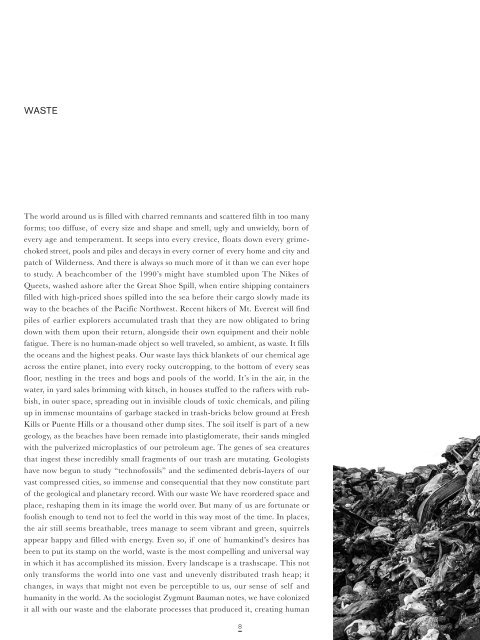Unnatural Nature
Create successful ePaper yourself
Turn your PDF publications into a flip-book with our unique Google optimized e-Paper software.
WASTE<br />
The world around us is filled with charred remnants and scattered filth in too many<br />
forms; too diffuse, of every size and shape and smell, ugly and unwieldy, born of<br />
every age and temperament. It seeps into every crevice, floats down every grimechoked<br />
street, pools and piles and decays in every corner of every home and city and<br />
patch of Wilderness. And there is always so much more of it than we can ever hope<br />
to study. A beachcomber of the 1990’s might have stumbled upon The Nikes of<br />
Queets, washed ashore after the Great Shoe Spill, when entire shipping containers<br />
filled with high-priced shoes spilled into the sea before their cargo slowly made its<br />
way to the beaches of the Pacific Northwest. Recent hikers of Mt. Everest will find<br />
piles of earlier explorers accumulated trash that they are now obligated to bring<br />
down with them upon their return, alongside their own equipment and their noble<br />
fatigue. There is no human-made object so well traveled, so ambient, as waste. It fills<br />
the oceans and the highest peaks. Our waste lays thick blankets of our chemical age<br />
across the entire planet, into every rocky outcropping, to the bottom of every seas<br />
floor, nestling in the trees and bogs and pools of the world. It’s in the air, in the<br />
water, in yard sales brimming with kitsch, in houses stuffed to the rafters with rubbish,<br />
in outer space, spreading out in invisible clouds of toxic chemicals, and piling<br />
up in immense mountains of garbage stacked in trash-bricks below ground at Fresh<br />
Kills or Puente Hills or a thousand other dump sites. The soil itself is part of a new<br />
geology, as the beaches have been remade into plastiglomerate, their sands mingled<br />
with the pulverized microplastics of our petroleum age. The genes of sea creatures<br />
that ingest these incredibly small fragments of our trash are mutating. Geologists<br />
have now begun to study “technofossils” and the sedimented debris-layers of our<br />
vast compressed cities, so immense and consequential that they now constitute part<br />
of the geological and planetary record. With our waste We have reordered space and<br />
place, reshaping them in its image the world over. But many of us are fortunate or<br />
foolish enough to tend not to feel the world in this way most of the time. In places,<br />
the air still seems breathable, trees manage to seem vibrant and green, squirrels<br />
appear happy and filled with energy. Even so, if one of humankind’s desires has<br />
been to put its stamp on the world, waste is the most compelling and universal way<br />
in which it has accomplished its mission. Every landscape is a trashscape. This not<br />
only transforms the world into one vast and unevenly distributed trash heap; it<br />
changes, in ways that might not even be perceptible to us, our sense of self and<br />
humanity in the world. As the sociologist Zygmunt Bauman notes, we have colonized<br />
it all with our waste and the elaborate processes that produced it, creating human<br />
8


